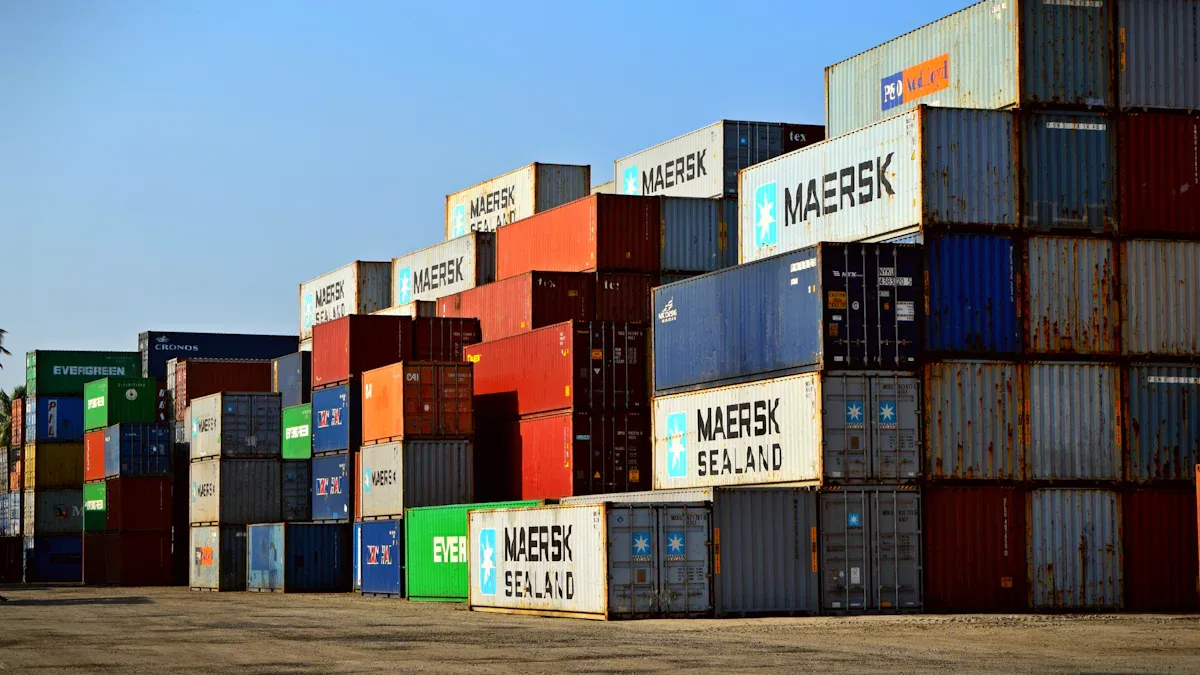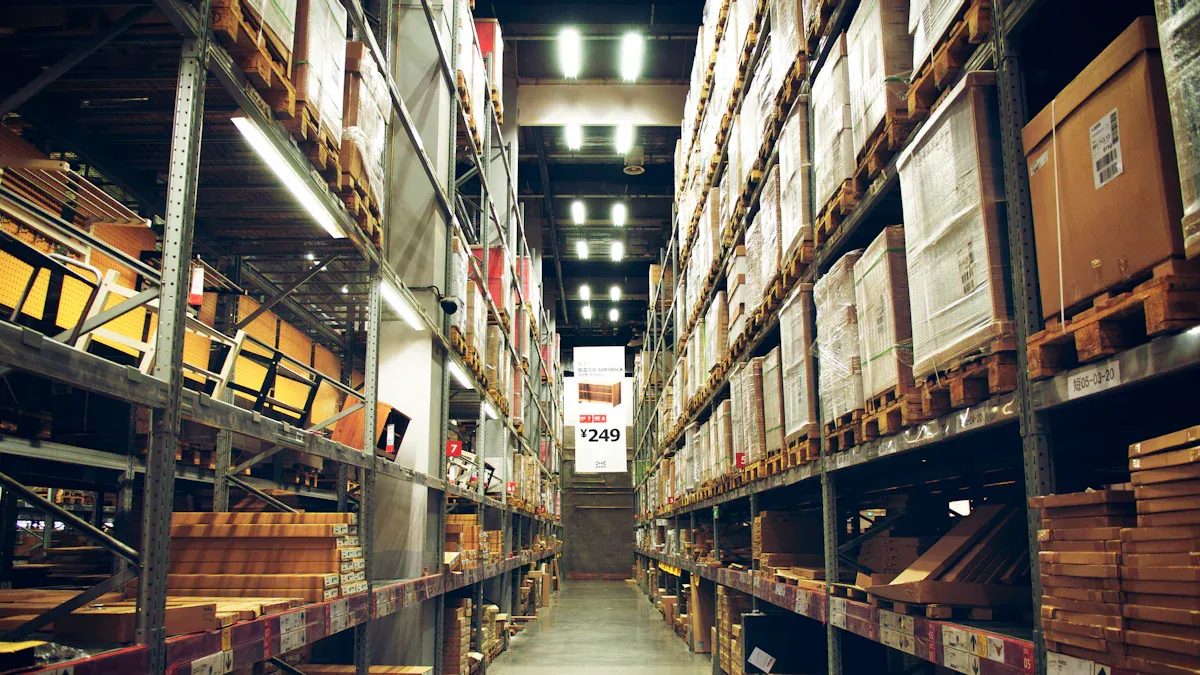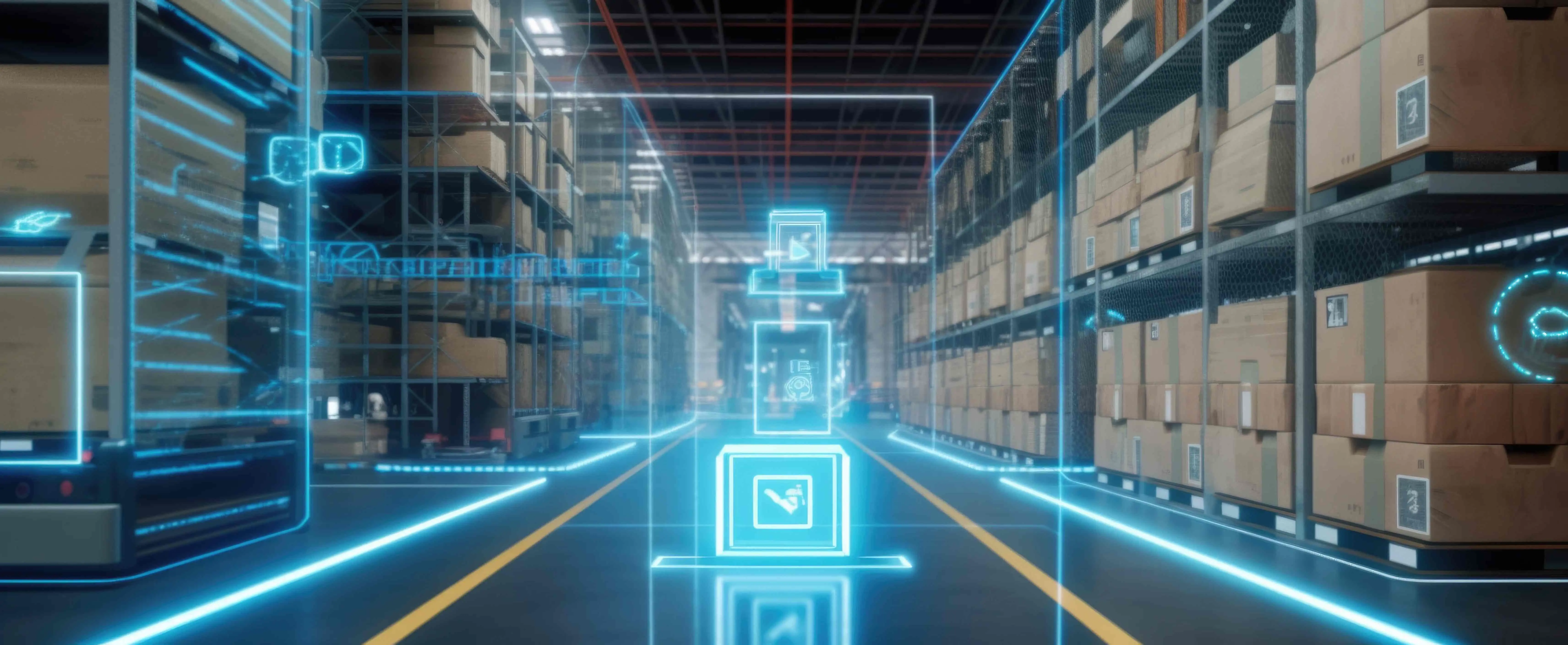Building a Resilient Supply Chain Network Through Digital and Intelligent Procurement System

In today's unpredictable global market, resilient supply chains have become a necessity. Studies reveal that 85% of executives are planning significant supply chain changes to address trade conflicts and tariffs. Digital and intelligent procurement systems, such as JUSDA's JusLink, provide businesses with tools to adapt and thrive. These systems enhance supply chain agility by automating operations, improving visibility, and enabling real-time collaboration. For example, 55% of manufacturing-related companies prioritize visibility improvements, while 85% of leaders adopt AI to strengthen resilience. Such advancements ensure supply chain flexibility, mitigate risks, and foster long-term adaptability.
Key Takeaways
Digital tools help businesses see the supply chain clearly. They can track each step and fix problems early.
Using data helps companies predict needs and make better choices. This improves how they work and adjust to changes.
Automation makes buying processes faster and cheaper. It lets teams spend time on important tasks.
Watching in real-time helps stop problems before they grow. This keeps business running smoothly.
Working with many suppliers makes businesses stronger. It lowers risks from depending on one vendor and helps handle market changes.
The Role of Digital and Intelligent Procurement Systems

Enhancing Visibility Across the Supply Chain
Visibility is a cornerstone of supply chain resilience. Digital tools like JUSDA's JusLink provide end-to-end visibility, enabling businesses to monitor every stage of their supply chain. This transparency allows organizations to identify inefficiencies, reduce waste, and streamline operations. For example, supply chain visibility empowers companies to detect risks early and take proactive measures to prevent disruptions. Real-time analytics further enhance decision-making, ensuring better strategic planning and operational performance.
A study highlights the importance of visibility in supply chain management. Only 6% of organizations achieve full visibility, while 62% operate with limited visibility. Companies that prioritize visibility report improved responsiveness to market demands, better risk mitigation, and enhanced customer satisfaction. These benefits make visibility a top strategic priority for businesses aiming to overcome supply chain challenges.
Statistic | Value |
|---|---|
Proactive supply chain network | |
Limited visibility | 62% |
Full visibility | 6% |
Extended visibility | 17% |
Supply chain visibility as a priority | Top strategic priority |
Leveraging Data Analytics for Smarter Decisions
Data analytics transforms how businesses address supply chain challenges. Predictive analytics, for instance, uses historical data to forecast future scenarios, helping companies adapt to sudden demand fluctuations. Real-time analytics provides insights into material and product demand, enabling accurate forecasting and better decision-making. By integrating data from suppliers, distributors, and retailers, businesses gain a comprehensive view of their supply chain performance.
Organizations that leverage analytics report significant improvements. For example, Goodyear uses predictive analytics to optimize tire design and maintenance, enhancing customer satisfaction and product lifecycle. Similarly, Domino's employs marketing analytics to reduce waste and increase profitability. These examples demonstrate how analytics empowers decision-makers to identify bottlenecks, streamline processes, and improve overall efficiency.
Metric Type | Description |
|---|---|
Quantifiable yardsticks for measuring success, helping organizations identify areas for improvement. | |
Data Integration | Combines data from various sources to provide a holistic view of supply chain performance. |
Predictive Analytics | Uses historical data to forecast future scenarios, improving efficiency and decision-making. |
Real-time Data | Enables businesses to adapt quickly to demand fluctuations and emerging trends. |
Automating Procurement for Greater Efficiency
Automation revolutionizes procurement by reducing processing times and improving efficiency. Automated systems streamline repetitive tasks, such as purchase order creation and invoice approvals, allowing procurement teams to focus on strategic activities. For instance, organizations implementing robotic process automation (RPA) in procurement report an average cost reduction of 20%. Automation also enhances visibility into supplier performance, enabling better compliance and negotiation power.
Operational efficiency metrics validate the impact of automation. Top-performing companies reduce purchase order cycle times to just five hours, compared to 48 hours for laggards. Deloitte reports that automation can cut procurement cycle times by up to 50%. These advancements not only save time but also reduce administrative costs, making automation a critical component of modern supply chain technologies.
Metric | Description |
|---|---|
Purchase Order Cycle Time | Time from purchase requisition creation to order transmission; top performers take 5 hours vs. laggards at 48 hours. |
Procurement Process Cost | Total administrative cost of managing a purchase order; varies widely by industry, from $35 to over $1,000 per PO. |
Real-Time Monitoring and Proactive Risk Management
Real-time monitoring plays a pivotal role in ensuring supply chain resilience. By leveraging advanced technologies, businesses can track operations, identify risks, and implement solutions before disruptions occur. Proactive risk management complements this approach by enabling organizations to anticipate and mitigate potential challenges, ensuring smooth operations and minimizing losses.
The Benefits of Real-Time Monitoring
Real-time monitoring provides businesses with a comprehensive view of their supply chain. It allows them to track goods, monitor inventory levels, and detect inefficiencies early. For instance, real-time analytics helps organizations identify bottlenecks, reducing operational costs and improving overall efficiency. Enhanced transparency ensures that issues are addressed promptly, minimizing risks of delays or damaged goods.
Organizations that adopt real-time monitoring report significant improvements in performance. A manufacturing company, for example, uses AI to monitor machine performance. When abnormal vibration patterns are detected, the system triggers an investigation, preventing potential operational risks. Similarly, a financial institution prioritizes audits based on liquidity risk indicators, focusing on areas with increasing cash flow volatility. These examples demonstrate how real-time monitoring enhances decision-making and operational stability.
Proactive Risk Management in Action
Proactive risk management involves identifying and addressing risks before they escalate. Tools like EHS software enable organizations to maintain a risk register, track controls, and implement measures to prevent incidents. For example:
Real-time alerts for barrier health allow businesses to address issues before they become serious risks.
A technology company sets thresholds for cybersecurity incidents. If phishing attempts exceed the threshold, an immediate audit is triggered.
Continuous evaluation of control effectiveness ensures that safety measures remain robust.
These practices highlight the importance of staying ahead of potential disruptions. By analyzing reported data, organizations can uncover hazards and implement controls proactively. Management of Change (MOC) processes also benefit from streamlined assessments, ensuring that proposed changes do not introduce new risks.
Real-Time Monitoring and Cost Optimization
Real-time monitoring not only mitigates risks but also optimizes costs. Early identification of inefficiencies reduces storage expenses, transportation costs, and losses from delays. For example, a manufacturing company using AI to monitor machine performance can avoid costly breakdowns by addressing issues early. This proactive approach ensures that resources are used efficiently, contributing to overall cost savings.
The integration of real-time monitoring and proactive risk management creates a robust supply chain. Businesses gain the ability to respond swiftly to challenges, maintain operational continuity, and enhance customer satisfaction. These strategies are essential for navigating the complexities of modern supply chains.
Strategies for Building a Resilient Supply Chain

Supplier Diversification to Mitigate Risks
Supplier diversification plays a critical role in mitigating risks and ensuring supply chain continuity. By sourcing materials from multiple suppliers, businesses reduce their reliance on a single vendor, minimizing the impact of disruptions. A major telecommunications company demonstrated this by using historical data and statistical modeling to evaluate delivery delays. This approach enabled informed decisions about inventory management and supplier diversification, reducing the likelihood of production halts.
Diversification also enhances flexibility, allowing companies to adapt to sudden market changes. For example, manufacturing firms that diversified suppliers during the pandemic experienced fewer disruptions compared to those reliant on a single source. Strengthening supplier relationships further supports this strategy, ensuring on-time deliveries and fostering close collaboration. These practices collectively improve continuity and resilience in supply chain management.
Real-Time Data and Analytics for Better Forecasting
Real-time data and analytics empower businesses to anticipate supply chain challenges and optimize operations. Predictive models, such as Granger causality, have improved forecasting accuracy across industries. In retail, integrating promotional data enhanced sales forecasts, leading to increased revenue. Similarly, healthcare providers used environmental data to predict admission spikes, enabling better resource allocation.
Supply chain resilience benefits significantly from these insights. Real-time analytics allow businesses to monitor inventory levels, predict demand fluctuations, and implement contingency planning. This proactive approach reduces the risk of overstocking or stockouts, ensuring operational continuity. Companies leveraging analytics report improved decision-making and greater adaptability to market dynamics.
Industry | Methodology | Results |
|---|---|---|
Financial | Granger causality with economic data | 15% reduction in portfolio RMSE due to better predictive models. |
Healthcare | Granger causality with environmental data | Better resource allocation during peak periods. |
Retail | Granger causality with promotional data | Enhanced sales forecasts and increased revenue. |
Strengthening Collaboration with Suppliers
Collaboration with suppliers is essential for building a resilient supply chain. Advanced procurement systems facilitate close collaboration by streamlining communication and improving transparency. For instance, Air France adopted Lean Agile Procurement, enabling vendor selection within six weeks through collaborative workshops. This approach expedited project initiation and improved supplier relationships.
Swiss Casinos Group also modernized its procurement processes, achieving a 400% faster time to deliver value and a 50% reduction in effort. These examples highlight how collaboration fosters agility and mitigates supply chain disruptions. By working closely with suppliers, businesses can address challenges proactively, ensuring flexibility and continuity in their operations.
Ensuring Scalability and Flexibility in Procurement Systems
Scalability and flexibility are essential for modern procurement systems to address supply chain challenges effectively. Businesses require systems that can adapt to growth, accommodate changing demands, and ensure continuity in operations. Advanced e-procurement platforms, such as JUSDA's JusLink, provide the tools necessary to achieve these goals.
E-procurement systems are designed to scale seamlessly as organizations expand or enter new markets. They can handle an increasing number of users, suppliers, and transactions without compromising performance. Modular capabilities allow businesses to start with basic functionalities and add advanced features, such as analytics and forecasting, as their needs evolve. This adaptability ensures alignment with strategic goals while minimizing the need for costly upgrades.
The following table highlights key features of scalable procurement systems and their benefits:
Feature | Benefit |
|---|---|
AI-driven solutions | Streamlines processes and enhances supplier relationships through real-time collaboration. |
Centralized management | Facilitates oversight and control over procurement activities, ensuring efficiency. |
Modular capabilities | Allows customization and scalability according to specific business needs. |
Adaptability to growth | Accommodates changes in supplier base and procurement needs without additional costs. |
Scalable systems also enhance inventory management by providing real-time insights into stock levels and demand patterns. This capability reduces the risk of overstocking or stockouts, ensuring operational continuity. For example, JusLink's intelligent replenishment feature dynamically adjusts inventory levels based on predictive analytics, helping businesses respond to market fluctuations efficiently.
Flexibility in procurement systems enables organizations to mitigate supply chain disruptions. By integrating real-time data and analytics, businesses can identify potential risks early and implement proactive measures. This approach not only minimizes losses but also strengthens resilience in the face of unforeseen challenges.
Success Stories in Supply Chain Resilience
How JUSDA’s JusLink Enhances Supply Chain Visibility
JUSDA’s JusLink platform has revolutionized supply chain visibility through its advanced digital solutions. It offers real-time tracking and analytics, enabling businesses to monitor operations and address issues proactively. Features like dynamic inventory management and automated procurement streamline processes, reducing manual errors and boosting productivity. JusLink’s end-to-end visibility ensures that businesses can identify inefficiencies and optimize their supply chain operations effectively.
The platform’s impact is evident in measurable improvements. Companies using JusLink report enhanced operational efficiency and accuracy. For instance, automation in warehousing has significantly minimized errors, while real-time analytics have improved decision-making. These advancements highlight JusLink’s role in strengthening supply chain resilience and ensuring seamless operations.
JUSDA’s Collaboration with SHARP: A Case Study in Supplier Diversification
JUSDA’s partnership with SHARP demonstrates the importance of supplier diversification in mitigating risks. SHARP faced challenges in managing its global supply chain, including high logistics costs and complex e-commerce operations. By leveraging JUSDA’s Supply Chain Management Collaboration Platform, SHARP diversified its supplier base and optimized its logistics network.
This collaboration resulted in a 20% reduction in logistics costs and improved order processing cycles. SHARP’s ability to adapt to market changes and maintain consistent product availability underscores the value of supplier diversification. The case study illustrates how strategic partnerships and advanced digital tools can address supply chain challenges effectively.

JUSDA Solutions
To provide you with professional solutions and quotations.
Lessons from Industry Leaders on Building Resilient Supply Chains
Supply chain resilience has become a critical factor in navigating today’s complex global market. Digital and intelligent procurement systems, such as JUSDA’s JusLink, play a transformative role in addressing these challenges. They enhance visibility, improve forecasting, and enable proactive risk management, ensuring businesses remain agile and competitive.
JUSDA’s JusLink empowers businesses to build a resilient supply chain by integrating AI-driven tools, real-time monitoring, and intelligent forecasting. These features ensure operational continuity and adaptability in the face of disruptions. Companies can leverage JusLink to optimize their supply chain processes, reduce risks, and achieve long-term sustainability.
To future-proof your supply chain, explore JUSDA’s innovative solutions today.
FAQ
Can small businesses benefit from digital procurement systems?
Yes, small businesses can use digital procurement systems to streamline operations, reduce costs, and improve efficiency. These systems provide tools for better supplier management, inventory tracking, and data-driven decision-making, enabling smaller enterprises to compete effectively.
How does automation enhance procurement efficiency?
Automation reduces manual tasks like order processing and invoice approvals. It accelerates procurement cycles, lowers administrative costs, and minimizes errors. Businesses can focus on strategic activities, improving overall efficiency and productivity.
What industries benefit most from JUSDA’s solutions?
JUSDA serves industries like electronics, automotive, FMCG, and healthcare. Its tailored solutions address specific challenges, such as complex logistics and inventory management, ensuring efficient and resilient supply chain operations.
See Also
Boosting Supply Chain Efficiency Through Cloud Innovations
Transforming Future Logistics with Artificial Intelligence Solutions
Revolutionizing Supply Chain Operations with Cloud Technologies
Is Your Supply Chain Prepared for a Digital Transformation?
Exploring AI Integration for the Next Generation Supply Chain
